Going on a Nile Cruise? Explore These 6 Amazing Sites in Luxor & Aswan
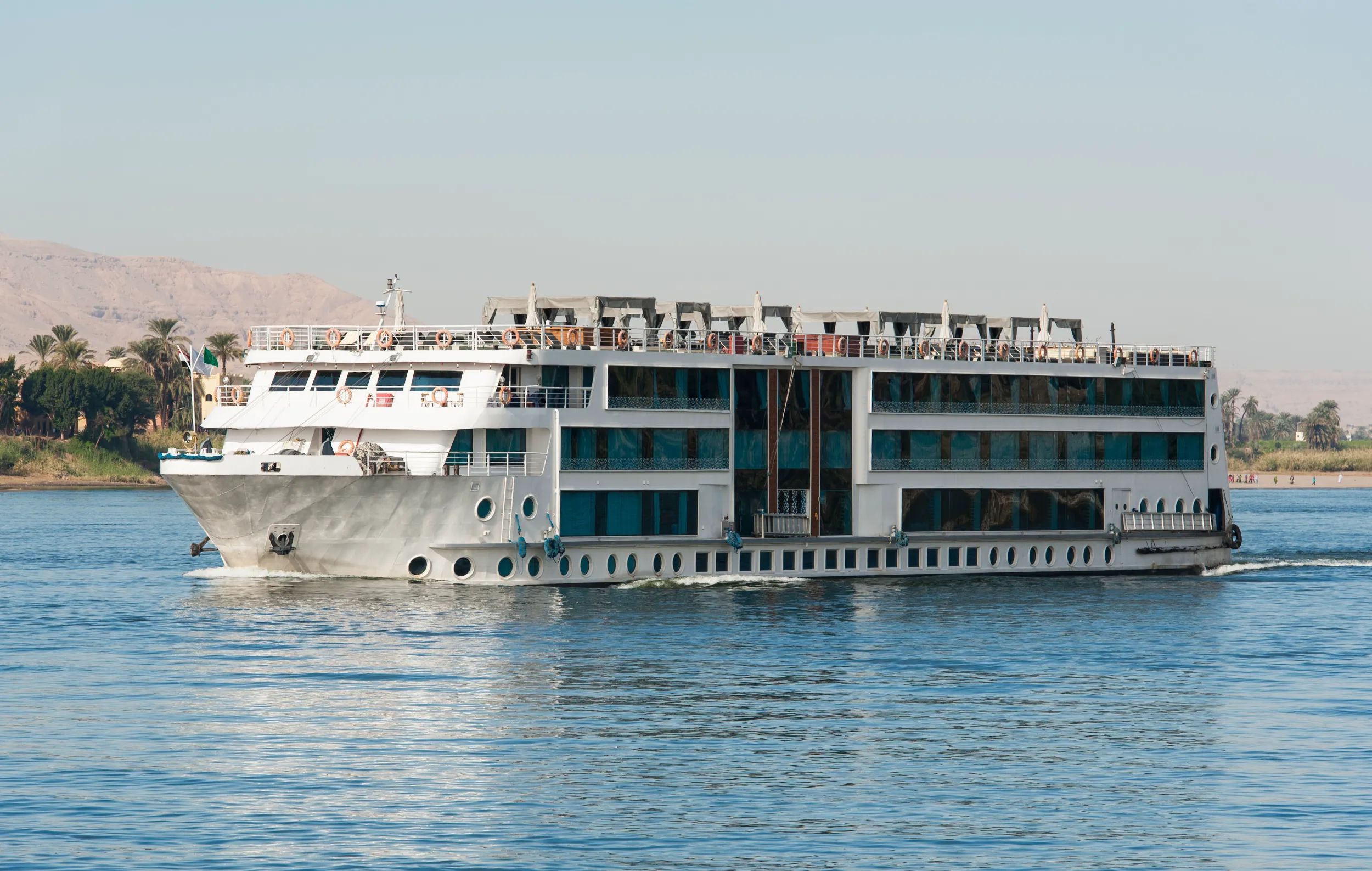
Updated On: February 19, 2024 by Marwa Abdel Moniem
A ship sailing down the stream of the Nile River is the dream of every cruise lover. But what makes this journey down the Nile, the lifeline of Egypt, so unique is its close relation with the ancient Pharaonic civilisation.
Going on a Nile cruise is an excellent chance to enjoy the flow of the river while learning about ancient Egypt—an experience that could take you over the moon! In this article, we will focus on voyages between the Upper Egyptian cities of Luxor and Aswan, both of which are famous for their awe-striking attractions. We guarantee this will be a different journey down one of the longest rivers in the world.
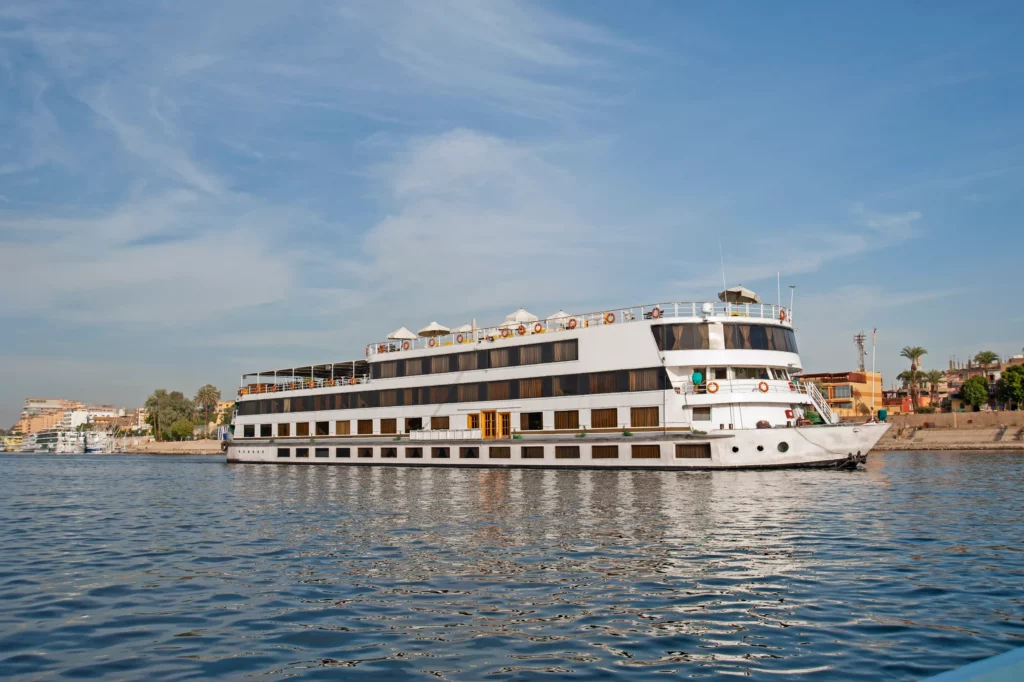
Table of Contents
Facts about the Nile River
Well, the Nile is the longest river in Africa, that’s for sure. Flowing from south to north through 11 African countries over 6,650 kilometres, the Nile is best associated with Egypt, the downstream country and final stop before the river empties into the Mediterranean. It has two tributaries: the White Nile and the Blue Nile.
The White Nile begins at Lake Victoria, the chief reservoir of the river, in Tanzania and Uganda. The Blue Nile originates at Lake Tana in Ethiopia. The two tributaries merge in Khartoum, Sudan, before the river drains into the Mediterranean coast of Egypt. The Nile River also runs through Rwanda, the Democratic Republic of the Congo, Burundi, Kenya, Eritrea and South Sudan.
Egypt: The Gift of the Nile
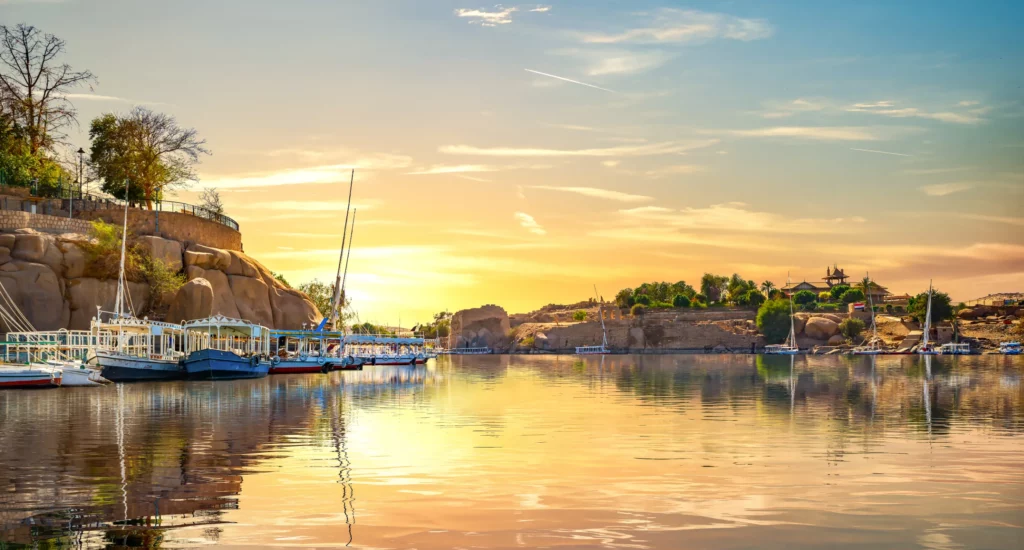
When the Nile rises, the Earth is joyous, and everyone is glad,
Every jaw laughs, and every tooth is uncovered.
The Hymn to the Nile flood
The Nile is life to Egypt—without it, Egypt would have literally been a desert. In ancient Egypt, it was the Nile River that provided the country with fertile soil for the cultivation of crops. The Nile River used to flood in August of every year, making the dry land of Egypt farmable. Ancient Egyptians could grow their own food. It was on the banks of the Nile River that the Egyptian civilisation flourished.
The ancient Egyptians believed the Nile was a gift providing them with water that they used in almost every aspect of their life, the greatest being to drink! They were very grateful for the Nile that helped bring lush green plants to their vast deserts. With water and food on the table, the ancient Egyptians had every reason to sing the praises of the Nile.
Usually, a flood is not perceived as a gift, but for the ancient Egyptians, it was. The Nile flooding used to leave behind black sediment that the ancient Egyptians used in agriculture. The river also provided the ancient Egyptians with clay, sandstone, granite and limestone, which were used in building.
It was on the banks of the Nile River that papyrus grew and was later used by the ancient Egyptians to make paper, sandals and baskets. Believe it or not, they also used papyrus to build boats because wood was scarce.
The Nile River also served as a major trade route in ancient Egypt. Trade prospered then, and the Nile River was credited for that. The ancient Egyptians used to make cargo, passenger and funeral boats.
Back then, the river was called Aur, meaning “black” — in reference to the black sediment created by the floods. It had the shape of the lotus flower, which symbolizes ancient Egypt and could be seen in Pharaonic arts and hieroglyphs shown on many archaeological sites in the Upper Egyptian cities of Luxor and Aswan.
Taking You on a Nile Cruise from Luxor to Aswan—Many Attractions along the Way!
Going on a journey down the Nile River is like travelling thousands of years back in time. The five-day cruise from Luxor to Aswan offers tourists magnificent views of many attractions as the boat floats along this popular Nile route.
Take your seat and have your camera set to capture many photos of monuments and temples standing on the sides of the Nile River. The Nile cruises also make frequent stops along the 200km between Luxor and Aswan. You can also pick a trip from Aswan to Luxor. Where to begin is your choice, but the landmarks you will see are the same. Here, we will focus on some of those highlights along the way.
The Karnak Temple
On the east bank of the Nile River stands the Karnak Temple—the world’s most incredible open-air museum. This three-in-one temple complex is located where the modern city of Luxor lies today.
The Temple of Amun-Ra is the largest of all three and is found in the centre of the complex. This is where, as the ancient Egyptians believe, the god and his family lived on Earth. Mut, the wife of Amun-Ra, has her temple in the south-most part of the complex. Located in the highest north part of this essential religious complex, the precinct of their son Khonsu is the smallest of all temples.
Stopping for a tour around the Karnak Temple, you will come across the Great Columns—a hallmark of the complex. It is often called the Great Hypostyle Hall, consisting of 134 giant sandstone columns capped by huge papyrus blossoms. Erected during the reign of Seti I, a 19th Dynasty pharaoh, the Great Hypostyle Hall occupies the heart of the Karnak complex. It is enclosed by massive walls that are still intact to a great extent today.
The Karnak was not only a religious complex in ancient Egypt. It also served as the treasury, administrative centre and palace of the pharaoh. The Karnak is, in a nutshell, the largest temple complex worldwide.
The Amazing Valley of the Kings
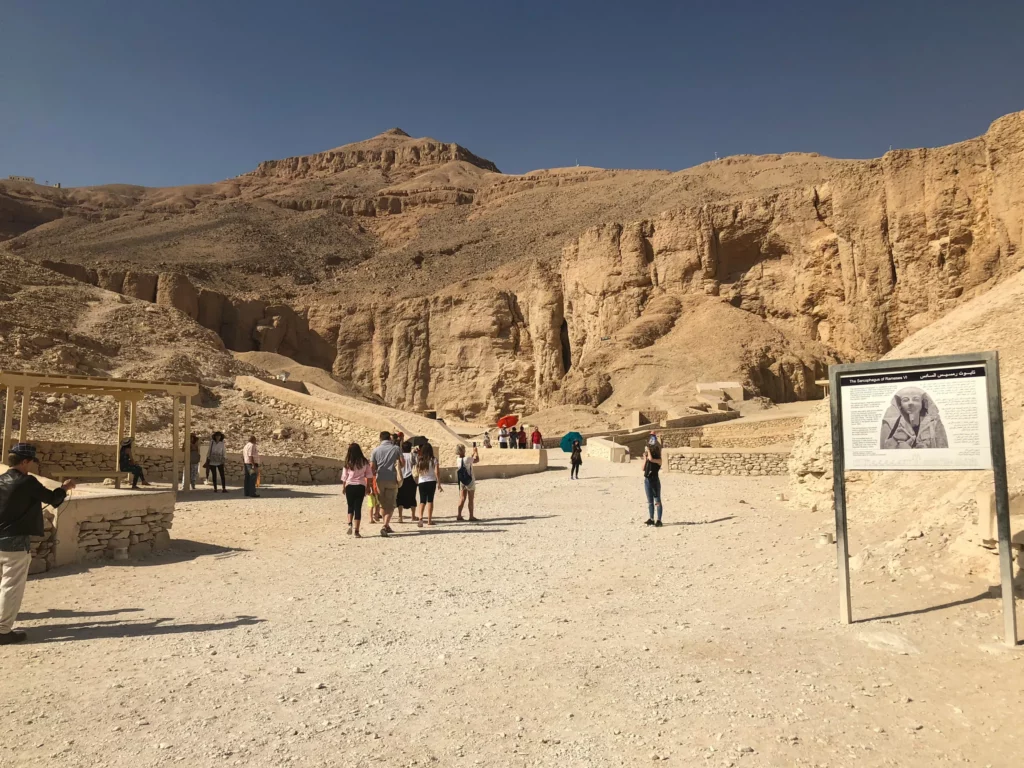
Located on the west side of the Nile River in today’s Luxor sits the Valley of the Kings. This World Heritage Site was the cemetery of the ancient Egyptian kings and their families. Not just that, but it was the burial place of their belongings as well!
This is where the bodies of kings from the 18th to the 20th dynasties, from Thutmose I to Ramses X, were laid to rest. We are talking about a place that served as a graveyard for nearly 500 years! The Valley of the Kings houses 62 known tombs with varied architectural designs.
Yes, the tombs were not built according to a standard blueprint. Their architectural features are different, and their designs as well. The Valley of the Kings includes small tombs with only a few compartments and large graves with many side rooms. Some tombs have sloping corridors, and others feature bent axis. You will get a satisfying dose of varied architectural designs!
Did you know that the ancient Egyptians believed in life after death? That’s why the Valley of the Kings was not designed to only serve as a royal necropolis but a cult place to perform rituals that, according to the ancient Egyptians, ensured eternal life. A true breathtaking burial place!
The Temple of Hatshepsut
The temple of Queen Hatshepsut is a stand-out mortuary temple, indeed a masterpiece of ancient architecture. Standing opposite the city of Luxor, the Temple of Hatshepsut was constructed to commemorate the achievements of the 18th Dynasty queen.
Built into a cliff face, the Temple of Hatshepsut includes sanctuaries to honour the gods relevant to the queen of Egypt. The walls of the Temple of Hatshepsut feature reliefs that not only depict the queen’s life and reign but also exhibit images of the gods.
Design-wise, the Temple of Hatshepsut is unique. It is made up of three massive terraces that lead to the main entrance. The lower terrace is enclosed by a wall with one entrance gate. Featuring impressive inscriptions, 22 columns are arranged in two rows along the halls of the terrace.
The middle terrace has 15 columns arranged in a single row at the north entrance. To the west, another portico houses 22 columns in two rows. Twenty-six columns are found in the forefront entrance of the upper terrace.
The Abu Simbel Temple
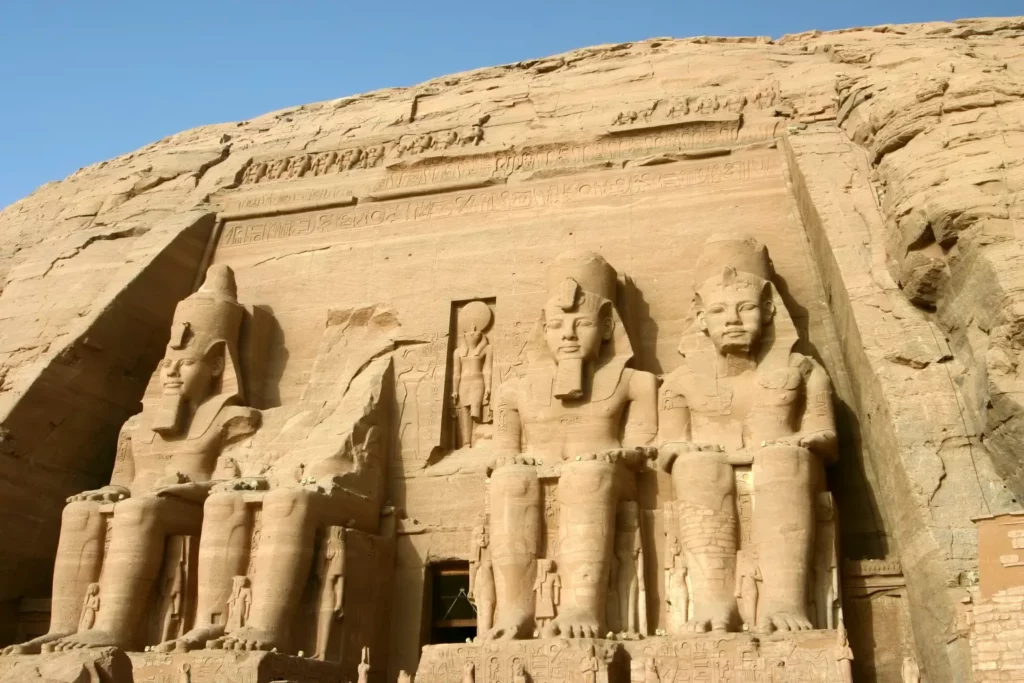
Stopping in Aswan, you should visit the Abu Simbel Temple. This historic site of two temples was established during the 19th Dynasty, the 13th century BC, by Pharaoh Ramses II for the ancient Egyptians to worship him after his death.
The twin temples feature four colossal rock-cut statues of Ramses II on the front. The unique look was due to an earthquake in 27 BC that caused the head of Ramses II to fall. The entire complex was moved to its current place to save it from the high water levels in Lake Nasser, the Aswan Dam Reservoir.
The four seated statues flank the entrance to the complex, two on each side. What is most impressive about the interior of the complex is its alignment with the rays of the rising sun twice every year to illuminate the statues of Ramses II on 22 February and 22 October. It would be very exciting if you happened to be visiting the complex on either days!
The Kom Ombo Temple
Meaning the “Hill of Gold”, the double temple of Kom Ombo, was constructed during the reign of King Ptolemy V from 205 to 180 BC right on the Nile River—it will catch your eyes from your seat on the cruise ship!
This limestone temple was dedicated to two ancient Egyptian deities: the crocodile-headed Sobek and the falcon-headed Horus. The symmetrical design of the temple is something to behold—with two entrances, two hypostyle halls and two sanctuaries dedicated to the two gods. The double temple has two matching sectors next to each other and was built as a rectangle.
The Philae Temple
The island-based temple in Aswan is truly a must-see. Built during the rule of Ptolemy II, the Philae Temple is one of the well-preserved Ptolemaic sites in Egypt nowadays. The Philae Temple was dedicated to Isis, Osiris, and Horus.
The walls of the temple feature scenes from the mythology of resurrection—Isis bringing Osiris back to life. Inscriptions on the walls also depict Isis giving birth to Horus and mummifying Osiris after his death.
The Philae Temple has two pylons connected through an open forecourt. The first pylon holds two towers, while the second contains a hypostyle hall with ten columns. The hypostyle hall leads to the burial place of the deity Isis.
Greek for “the end”, Philae has all the charm that brings visitors back again. It is never the end with the Philae Temple. Remember to attend the Sound and Light Show in Philae when stopping here—this is a true wonder to behold!
A Nile Cruise Has It All!
A relaxing journey down the Nile River and alongside many of the archaeological wonders of ancient Egypt is an all-in-one experience that you must have during your visit to the cities of Luxor and Aswan.
You could not ask for more! Explore the two upper Egyptian cities while enjoying the allure of the Nile River, and you will have many pictures to take and share. This journey could time-travel visitors for thousands of years in history. So, relax on your seat and get ready to soak it all up!






